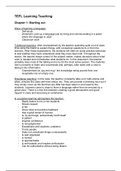Samenvatting
Summary TEFL CH1,2,4 CLT & Neuner
- Vak
- TEFL
- Instelling
- Hogeschool Arnhem En Nijmegen (HAN)
Beste medestudenten! Voor het vak TEFL (Teaching English in a Foreign Language) heb ik een samenvatting gemaakt uit het boek Learning Teaching. Voor ons eerste tentamen moesten we hoofdstukken 1, 2 en 4 kennen. Daarnaast hebben we een reader ontvangen waarin CLT en Neuner ook werd uitgelegd, dit mo...
[Meer zien]





